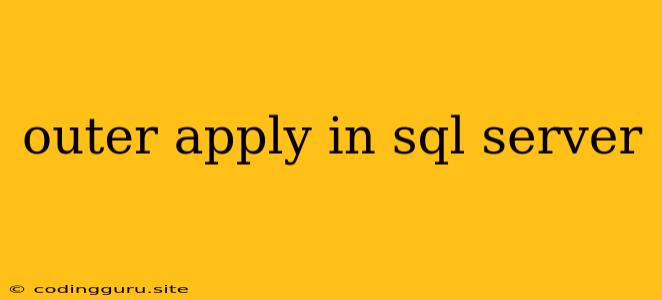Delving into the Power of OUTER APPLY in SQL Server
You're working with SQL Server and need a way to perform calculations, filter data, or retrieve related information without being limited by traditional JOIN operations. You've heard about OUTER APPLY and its potential, but you're unsure of how it truly works and where it shines. Let's dive into the world of OUTER APPLY to unlock its capabilities and understand its place in your SQL arsenal.
What is OUTER APPLY?
OUTER APPLY is a powerful operator in SQL Server that allows you to extend your queries with additional logic, similar to a correlated subquery. It acts like a LEFT JOIN but lets you execute a subquery for each row in the left table, even if there's no corresponding match in the right table. Think of it as a LEFT JOIN on steroids, allowing you to dynamically generate values and enrich your result set.
Why Use OUTER APPLY?
OUTER APPLY offers a unique approach to SQL queries, making it a valuable tool for various scenarios:
- Dynamic Calculations: You can perform calculations based on the values from the left table for each row, even if no matching rows exist in the right table.
- Data Enrichment: Use OUTER APPLY to fetch related data from other tables or perform complex logic based on your current row.
- Replacing Correlated Subqueries: OUTER APPLY can often simplify complex queries with correlated subqueries, making your code more readable and efficient.
- Conditional Logic: Implement conditional logic within your OUTER APPLY subquery to retrieve specific data based on the current row's values.
Understanding the Syntax
SELECT
t1.column1,
t1.column2,
t2.column3,
t2.column4
FROM
table1 t1
OUTER APPLY (
SELECT
column3,
column4
FROM
table2 t2
WHERE
t2.join_column = t1.join_column
) t2;
Here's a breakdown of the syntax:
SELECT: The mainSELECTclause specifies the columns you want to retrieve from the left table (t1) and the subquery (t2).FROM: TheFROMclause lists the main table (table1) that will be used for the OUTER APPLY.OUTER APPLY: This keyword marks the start of the subquery.SELECTwithinOUTER APPLY: ThisSELECTstatement defines the columns you want to retrieve from the subquery.FROMwithinOUTER APPLY: ThisFROMclause specifies the table (table2) for the subquery.WHEREwithinOUTER APPLY: This optional clause filters the results of the subquery based on conditions that may reference columns from the left table (t1).t2: This is the alias given to the subquery. You can use it to reference the subquery's columns in the mainSELECTstatement.
How OUTER APPLY Works
OUTER APPLY operates like a LEFT JOIN but with an important difference: it executes the subquery for each row in the left table, even if there are no matching rows in the right table.
This allows you to dynamically generate values, retrieve related information, or perform calculations based on each row in the left table, even if no matches exist in the right table.
Example Scenario
Imagine you have a table Orders containing customer orders and a table Products containing product information. You want to retrieve all orders and their associated product names, even if some orders don't have a matching product.
Here's how you can do it using OUTER APPLY:
SELECT
o.OrderID,
o.CustomerID,
p.ProductName
FROM
Orders o
OUTER APPLY (
SELECT
ProductName
FROM
Products p
WHERE
p.ProductID = o.ProductID
) p;
This query will return all orders, including those that don't have a matching product in the Products table. For orders without a matching product, ProductName will be NULL.
Key Points to Remember
- OUTER APPLY is not a substitute for LEFT JOIN in all cases. Use LEFT JOIN when you need to retrieve all matching rows between two tables.
- OUTER APPLY allows you to execute a subquery for each row in the left table, even if there's no match in the right table, offering greater flexibility.
- OUTER APPLY is a powerful tool for performing calculations, enriching data, and handling complex logic within your SQL queries.
Conclusion
OUTER APPLY is a valuable addition to your SQL toolkit, enabling you to perform dynamic calculations, enrich your data, and simplify complex queries. By understanding its capabilities and exploring different use cases, you can effectively utilize OUTER APPLY to enhance your SQL queries and solve challenging data manipulation problems.
